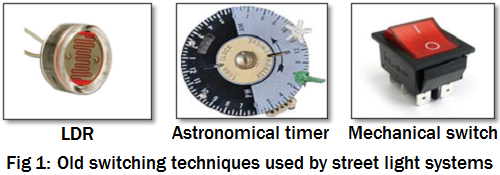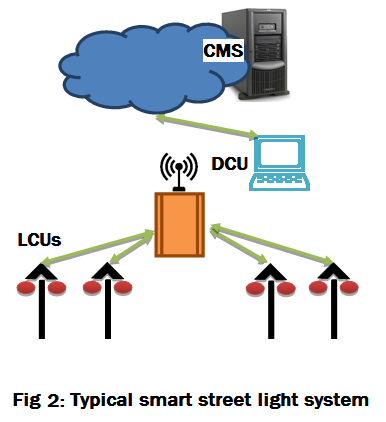A significant portion of the national electricity production goes to street lighting. The existing street lighting solution models in different parts of the world are not very efficient and optimised. Due to the same reason, we often find street lights ON during the day time and OFF during the night. Imagine thousands of street lights consuming thousands of watts, wasting away precious electricity. It also reduces the usable life of the lamps. This gives us a substantial scope for improvement in the way street lighting systems operate today. The suggested approach to bringing about improved operational efficiency focuses on two aspects – replacing existing lamps with light-emitting diode (LED) lamps and making the street lights ‘smarter’.
Current street lighting systems
The existing solutions are based on either of the following techniques:
- Manual switching: This is the classic and omnipresent technique. The light is switched ON and OFF by a human attendant.
- Light dependent resistance (LDR): LDR-based lights can switch themselves ON and OFF according to the ambient light conditions. Tolerance variation in LDRs requires manual tuning of threshold levels in individual lights, typically using potentiometers. Dust deposits can also affect the sensitivity. Such factors reduce the reliability of the system.
- Astronomical Timers: These devices choose the switch ON or switch OFF time depending on the date on the calendar. The devices are preprogrammed according to the location of the installation. This scheme is inflexible, does not take care of variable light situations such as overcast, dust storm etc.

The above systems are simple, economical and easy to install. However, these are not flexible and do not lend themselves to modern power-saving strategies. They provide limited monitoring capabilities.
Why smart lighting
The transformation from a classic street lighting system to a smart street lighting solution is primarily enabled by the ability of devices to connect to and communicate with each other. It means that the various components of a normal street lighting system can be interlinked via a communication network. This gives an operator the ability to individually control and monitor street lights in an entire locality. Such connected systems overcome the limitations of manual systems, and also allow one to:
- Remotely switch ON or switch OFF street lights and control their timings.
- Control parameters like intensity of individual street lights to attain maximum efficiency.
- Detect and report faults from remote locations and schedule appropriate maintenance activities. Such systems can detect faults in the lamp as well as the driving circuit. These can also detect overvoltage and undervoltage situations, presence of humidity in the enclosure and operating temperature among others.
- Identify the presence of pedestrians or vehicles to switch ON lights when they approach.
- Measure the power consumed by the light and detect power pilferage.
- Detect accidents or damage to the pole, by analysing the inputs from the motion sensors.
- Monitor additional parameters like pollution level, noise and ambient light level.
The advantages that a smart street lighting system offers in terms of maintenance are often underestimated. For example, the ability to identify a faulty street light from a central location and to send a crew only to repair that particular street light offers huge savings in time and money over the current approach of having to dispatch maintenance crew to check all the street lights one by one over a period of time as a routine activity.

Basic units of a smart street light system
The following are the key components of the proposed smart street light solution:
- Central Monitoring Station (CMS): It monitors the connected streetlights.
- Data Concentrator Unit (DCU): One unit is installed per street. This unit communicates with the CMS over a cellular network.
- Lamp Control Unit (LCU): An LCU is mounted on each streetlight.
Read Anatomy Of A ‘Smart’ Streetlight System to know more about the different units of a smart street light system.









Can you explain how exactly the switching on and off of the streetlighting system works?